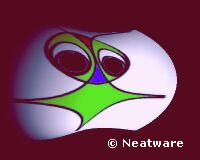Syntax
 The syntax of mCL is similar to Tcl that consists of variable, command, substitution and grouping.
The syntax of mCL is similar to Tcl that consists of variable, command, substitution and grouping.
A variable is represented as a string of case sensitive leters, numbers, and underscore bars. You can use a variable without declaring its type. You can also assign a value to a variable. Finally, you can get a variable value by substitution.
A command of mCL has the format
command argument1 argument2 ...
where command is a buildin or a defined procedure
in the mCL. Spaces separate a command name and its arguments in a
line. Newline and semicolons are command terminators. Each command
has a return value. To evaluate a command, interprter substitutes
command arguments from left to right, which makes a single passing
substitution, and then executes the command. For example, the set
command assigns a string "foo bar" to the variable var.
set var "foo bar"
A command name could be a variable as well. Usually a variable
command name used to represent an object. For example,
set app [MCL::application]
$app create
$app run
where app is an application object of mCL.
app is a variable to represent the object and $app gets the variable
value. $app then creates an real D3D environment object and starts to
run it.
There are variable and command substitution
Dollar sign $
enables variable substitution. It replaces the variable with its
value. ${variable} will be useful to distinguish from other special
characters.
set x $var
Square brackets [] enable command substitution. A command
must be inside the brackets. After evaluation of the command, the
return value will replace the square bracket string. The brackets
maybe nested. Following command returns an expression value.
[expr sin(x)*(a+b)]
Backslash \
enables next character substitution. The next character or group
after the backslash will be replaced by a new representation of the
character. Usually backslash \ is widely used to quote a specific
character. For example, the " inside a pair of "" should be
substituted by \".
"inside double quote \" "
"newline \n and tab \t "
Grouping collects several items as one item
Double quote "" grouping enables inside string substitution. The " character
inside the double quote must be disabled with the backslash \"
quoting. The grouping value of double quotes is the string inside
after substitution.
"dobule quote enable variable substitution {$variable}
and command substitution [clock seconds]"
Curly braces { } grouping disables substitution inside.
All the characters include whitespace,
double quotes, even nested curly braces (exclude outmost curly
braces) are value of the group. When curly braces are inside the
double quote, they will not work as grouping.
{curly braces disable variable substitution {$variable}
and command substitution [clock seconds]}
|
 Copyright ©2004-2015 Neatware. All Rights Reserved.
Copyright ©2004-2015 Neatware. All Rights Reserved. Copyright ©2004-2015 Neatware. All Rights Reserved.
Copyright ©2004-2015 Neatware. All Rights Reserved.